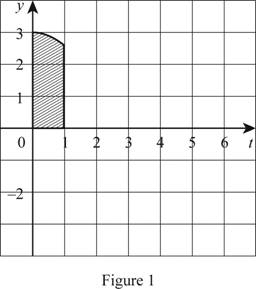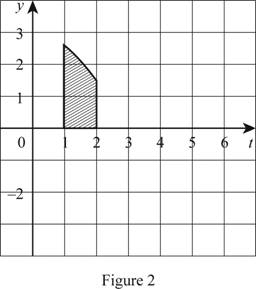
Concept explainers
(a)
The value of
(a)
Answer to Problem 4E
The value of
The value of
Explanation of Solution
Given information:
The equation is
The graph is given for the integral function
Calculation:
Show the integral function as below.
Here,
Determine
Substitute 0 for x in Equation (1).
Therefore, the
Determine
Refer the graph.
The curve is symmetrical about the point (3, 0). Hence, the area between the points 0 to 3 and 3 to 6 are equal with alternative sign.
Therefore, the function
(b)
The value of
(b)
Answer to Problem 4E
The value of
The value of
The value of
The value of
The value of
Explanation of Solution
Given information:
The equation is
The graph is given for the integral function
Calculation:
Draw the graph for calculation of

Determine
Substitute 1 for x in Equation (1).
Refer Figure (1).
Area of shaded rectangle is the function of t with limits 0 to 1.
Modify Equation (2).
Add 80% of unit square.
Substitute 1 for b, 2 for h.
Therefore,
Draw the graph for calculation of

Determine
Substitute 2 for x in Equation (1).
Refer Figure (2).
Area of shaded rectangle is the function of t with limits 1 to 2.
Substitute 2.8 for
Add 90% of unit square.
Substitute 1 for b and 1 for h.
Therefore,
Draw the graph for calculation of

Determine
Substitute 3 for x in Equation (1).
Refer Figure 3.
Area of shaded triangle is the function of t with limits 2 to 3.
Substitute 4.7 for
Substitute 1 for b and 1.2 for h.
Therefore,
Draw the graph for calculation of

Determine
Substitute 4 for x in Equation (1).
Refer Figure 4.
Area of shaded triangle is the function of t with limits 3 to 4.
Substitute 5.3 for
Substitute 1 for b and 1 for h.
Therefore,
Draw the graph for calculation of

Determine
Substitute 5 for x in Equation (1).
Refer to Figure 5.
Area of shaded portion is the function of t with limits 4 to 5.
Substitute 4.7 for
Subtract 90% of third unit square.
Substitute 1 for, 1 for h.
(c)
The interval when g is increasing.
(c)
Answer to Problem 4E
The function g is increasing at the interval
Explanation of Solution
Given information:
The equation is
The graph is given for the integral function
Calculation:
Refer to Part (a).
The value of g is increasing from the interval 0 to 3.
Therefore, the function g is increasing at the interval
(d)
The location of maximum value of g.
(d)
Answer to Problem 4E
The maximum value of g lies at
Explanation of Solution
Given information:
The equation is
The graph is given for the integral function
Calculation:
Refer part (a) calculation
Maximum value of g lies at
Therefore, the maximum value of g lies at
(e)
To Sketch: The rough graph of g.
(e)
Explanation of Solution
Plot the graph for function f using the calculated values of 0, 2.8, 4.7, 5.3 and 4.7 for the functions
Show the graph for function f as in Figure 6.

(f)
To Sketch: The graph
(f)
Explanation of Solution
Show the graph for function
Draw the graph

Chapter 5 Solutions
Single Variable Calculus: Concepts and Contexts, Enhanced Edition
 Calculus: Early TranscendentalsCalculusISBN:9781285741550Author:James StewartPublisher:Cengage Learning
Calculus: Early TranscendentalsCalculusISBN:9781285741550Author:James StewartPublisher:Cengage Learning Thomas' Calculus (14th Edition)CalculusISBN:9780134438986Author:Joel R. Hass, Christopher E. Heil, Maurice D. WeirPublisher:PEARSON
Thomas' Calculus (14th Edition)CalculusISBN:9780134438986Author:Joel R. Hass, Christopher E. Heil, Maurice D. WeirPublisher:PEARSON Calculus: Early Transcendentals (3rd Edition)CalculusISBN:9780134763644Author:William L. Briggs, Lyle Cochran, Bernard Gillett, Eric SchulzPublisher:PEARSON
Calculus: Early Transcendentals (3rd Edition)CalculusISBN:9780134763644Author:William L. Briggs, Lyle Cochran, Bernard Gillett, Eric SchulzPublisher:PEARSON Calculus: Early TranscendentalsCalculusISBN:9781319050740Author:Jon Rogawski, Colin Adams, Robert FranzosaPublisher:W. H. Freeman
Calculus: Early TranscendentalsCalculusISBN:9781319050740Author:Jon Rogawski, Colin Adams, Robert FranzosaPublisher:W. H. Freeman
 Calculus: Early Transcendental FunctionsCalculusISBN:9781337552516Author:Ron Larson, Bruce H. EdwardsPublisher:Cengage Learning
Calculus: Early Transcendental FunctionsCalculusISBN:9781337552516Author:Ron Larson, Bruce H. EdwardsPublisher:Cengage Learning





